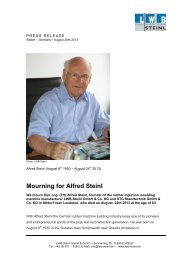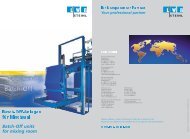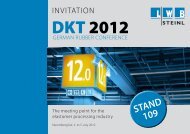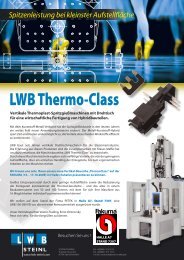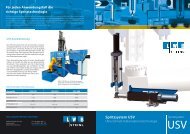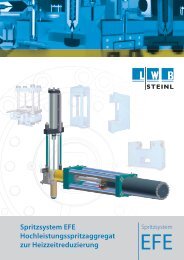Injection System USV - LWB Steinl GmbH & Co. KG
Injection System USV - LWB Steinl GmbH & Co. KG
Injection System USV - LWB Steinl GmbH & Co. KG
Create successful ePaper yourself
Turn your PDF publications into a flip-book with our unique Google optimized e-Paper software.
V/D<br />
© 2007 <strong>LWB</strong> <strong>Steinl</strong> Technical data subject to change!<br />
<strong>Injection</strong> moulding solutions<br />
for individual requirements<br />
<strong>LWB</strong> offers a wide range of injection units for different applications and requirements. <strong>LWB</strong> is continuously improving<br />
the injection systems based on our know-how and experience in rubber technology. This, together with a large custom<br />
base leads to a greater efficiency, precision and control of the injection systems. These developments have shown<br />
that different injection systems, depending on the respective application, have a great influence on the injecting process<br />
as well as the quality of the finished product.<br />
<strong>USV</strong> automation<br />
Especially the <strong>USV</strong> technology is easy to automate. By the<br />
use of the automation the output as well as the quality<br />
of the production can be increased similarly. The reason<br />
is, that the cycle times remains nearly constant resulting<br />
thus in constant working ,temperatures.<br />
This automation was done with a customer article, a belt<br />
pulley, produced in serial production. The belt pulley<br />
consists of two metal parts, inserted into the cavity by a<br />
robotic arm with gripping unit. The sprue will be removed<br />
and subsequently disposed with the help of a gripping<br />
unit as well as compressed air. The finished product will<br />
be taken by the gripping device and put at a defined<br />
position.<br />
Technical data <strong>USV</strong> injection system<br />
VR<strong>USV</strong> 1100/500, with 500 cm³ shot size,<br />
equipped with robotics technique for a fully<br />
automated production of rubber metall parts.<br />
Design <strong>USV</strong> 250 <strong>USV</strong> 320 <strong>USV</strong> 500<br />
<strong>Injection</strong> volume cm³ 250 320 500<br />
<strong>Injection</strong> pressure bar 1120 880 880<br />
<strong>Injection</strong> stroke mm 280 282 390<br />
Ø Ring piston mm 62 x 52 62 x 49 62 x 47<br />
Ø Screw mm 25 32 32<br />
Your professional partner<br />
<strong>LWB</strong> <strong>Steinl</strong> <strong>GmbH</strong> & <strong>Co</strong>. <strong>KG</strong><br />
Sonnenring 35<br />
84032 Altdorf/Germany<br />
Tel. +49 (0)871 308 - 0<br />
Fax +49 (0)871 308 - 180<br />
www.lwb-steinl.com<br />
<strong>Injection</strong> <strong>System</strong> <strong>USV</strong><br />
Ultra-Speed-Vulcanising Technology<br />
<strong>Injection</strong> <strong>System</strong><br />
<strong>USV</strong>
More flexibility, better cost management<br />
with <strong>USV</strong> injection technology<br />
We achieved a state of the art increasing the productivity of rubber<br />
vulcanisation. There is no doubt that a higher compound temperature in<br />
the cavity leads to shorter cure time and subsequently to higher output.<br />
In the beginning, the <strong>USV</strong> technology was developped for middle<br />
sized and large-volume rubber and rubber/metal parts. Now this<br />
injection technology is also available for multi-cavity moulds.<br />
Unique heating of the compound<br />
- Up to 75 % cure time reduction in comparison to traditional injection presses<br />
- Very smooth heating of compound during the cycle due to thermal conduction<br />
(no destruction of the polymer chain)<br />
- Homogeneous compound temperature in the cross section<br />
Quality improvement<br />
- single cavity production with middle and large-volume parts<br />
- no shearing of the compound<br />
- no residual rubber in the injection unit during the injection cycle<br />
Less rejects<br />
- constant production conditions<br />
- constant production due to robot application<br />
- faults that occur with multi cavities, are nearly avoided<br />
<strong>Co</strong>st reduction<br />
- use of prototype moulds for the production<br />
- less cavities due to shorter curing cycles for batch production<br />
- mould change very easy to handle (flexibility)<br />
- operation possible in manual as well as in automated mode<br />
- highly flexible production<br />
- easy and quick restart of production in case of mould change<br />
Rubber<br />
VC<strong>USV</strong> 500/300 Operating area<br />
protected by a light curtain<br />
TPE<br />
Fully automated 2K manufacturing cell with<br />
<strong>USV</strong> and robotics technique<br />
Production planning<br />
A new production run does not need high costs in the beginning, but can be<br />
increased step by step. The first press with prototype mould is applicable for pre-series<br />
production as well as for batch production without another acceptance procedure.<br />
To increase production capacity, further machine-units with simple 1-cavity moulds<br />
can be planned. Every mould, which is planned for future batch production, can<br />
unobstructed be used from the beginning. The small machine units can easily be used<br />
for other product production when demand decreases. Therefore production is very<br />
flexible.<br />
Particularities of the patended<br />
<strong>USV</strong> injection technology<br />
1. <strong>Co</strong>mpound is plastified in a „First in First<br />
out“ injection unit and the set volume is<br />
charged.<br />
2. Via the „First in First out“ injection unit the<br />
compound is charged into the ring piston<br />
injection unit and remains there during<br />
curing cycle for a dispersive heating.<br />
3.Heating of the compound is effected<br />
time controlled in the ring piston. Thus preheated,<br />
the compound is injected into the<br />
mould.<br />
4. A higher start temperature shortens<br />
curing time and therefore considerably the<br />
whole cycle time<br />
Cure time reduction is defined by the<br />
setpoint of temperature and duration of<br />
the pre-heating inside the ring-cylinder.<br />
This extremely smooth kind of heating can, Charging the injection unit during pre-heating<br />
especially with dynamically stressed parts,<br />
lead to a longer life-time. The duration of<br />
the injection cycle will be determinated by<br />
the prospective cure time reduction. <strong>USV</strong> This fact <strong>USV</strong><br />
<strong>USV</strong><br />
Baugröße<br />
does not cause any problems, 250as thick-walled 320<br />
500<br />
Spritzvolumen parts with cm³ larger volume automatically 250 have 320 500<br />
Spritzdruck longer bar heating periods and 1120 subsequently 880 880<br />
Spritzhub longer mm pre-heating periods. 280 282 390<br />
Ø Ringkolben mm 62 x 52 62 x 49 62 x 47<br />
With a testing phase over several years already<br />
this technique is leading to small, highly<br />
efficient production cells.<br />
Ø Schnecke mm 25 32 32<br />
Charging<br />
Inject<br />
<strong>USV</strong> INJECTION TECHNOLOGY



